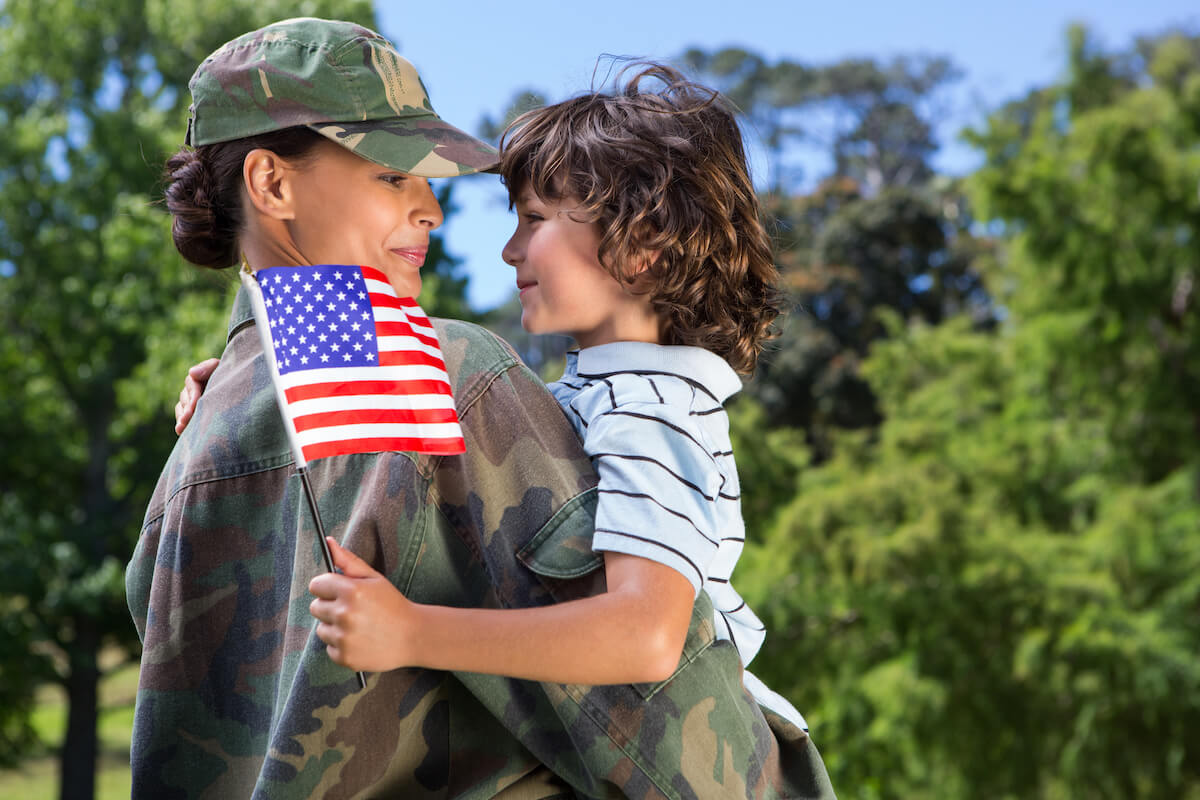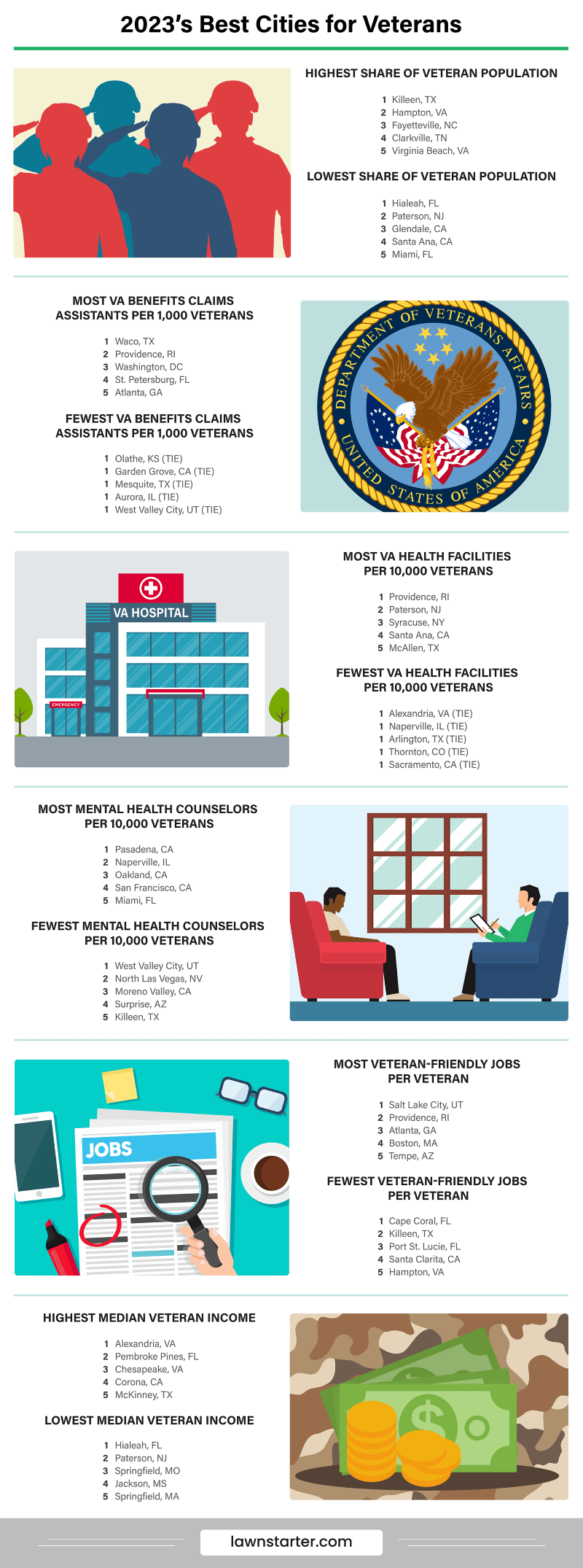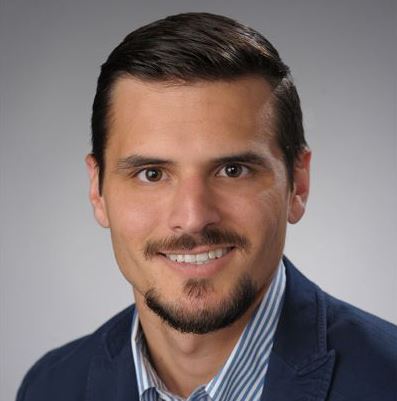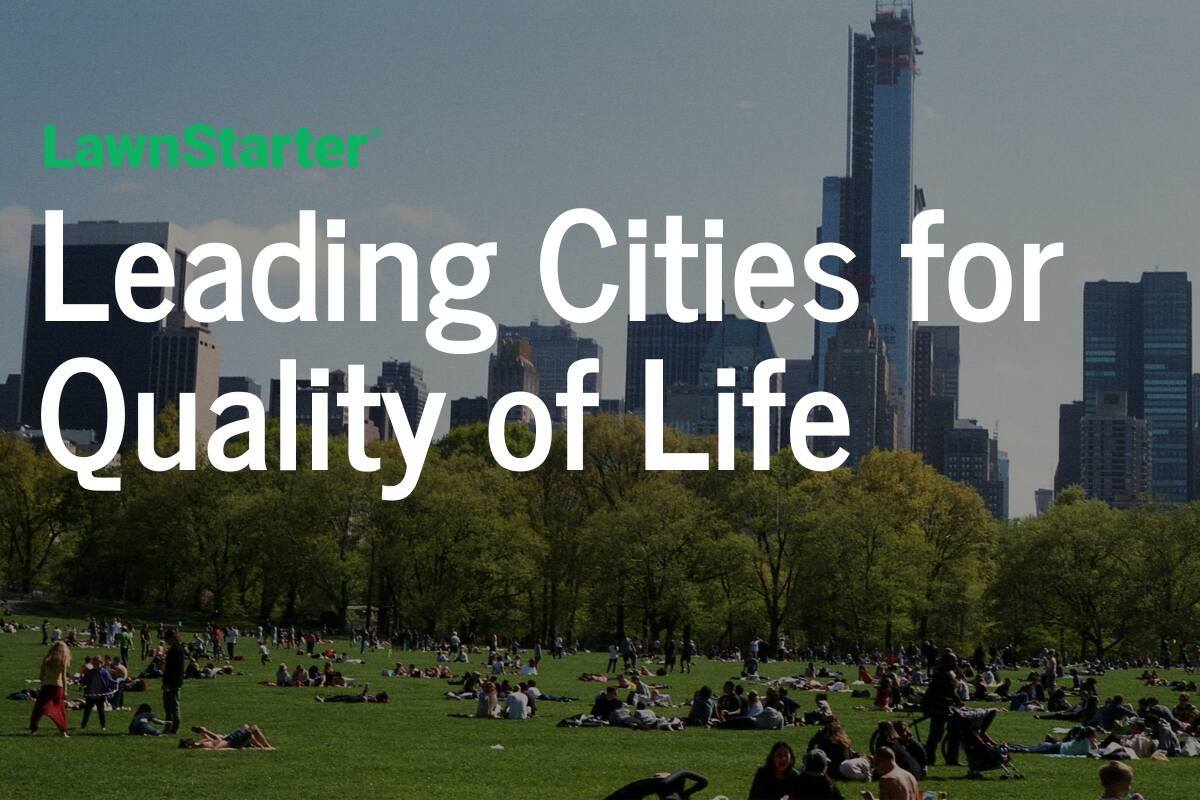
Adjusting to civilian life after serving in the armed forces can be a big challenge.
Which cities set up our vets for comfort and success?
To mark Veterans Day on Nov. 11, LawnStarter compared the 200 biggest U.S. cities to rank 2023’s Best Cities for Veterans.
We looked for cities with high populations of veterans and access to support resources like VA facilities, nonprofits, and PTSD recovery programs. We also considered housing affordability, as well as employment and educational opportunities, among 37 total metrics.
See where your city landed in our ranking below, followed by some highlights, lowlights, and expert tips.
Contents
City Rankings
See how each city fared in our ranking:
| Overall Rank (1=Best) | City | Overall Score | Community Rank | Support Rank | Medical Health Care Rank | Mental Health Care Rank | Housing Rank | Education and Training Rank | Employment and Volunteering Rank | Affordability Rank | Safety Rank |
|---|---|---|---|---|---|---|---|---|---|---|---|
| 1 | Providence, RI | 46.18 | 191 | 3 | 1 | 1 | 172 | 19 | 4 | 183 | 32 |
| 2 | Salt Lake City, UT | 41.71 | 104 | 7 | 7 | 2 | 83 | 3 | 2 | 129 | 169 |
| 3 | Miami, FL | 38.21 | 142 | 17 | 21 | 4 | 118 | 5 | 7 | 61 | 89 |
| 4 | St. Louis, MO | 35.42 | 74 | 8 | 10 | 16 | 99 | 2 | 36 | 114 | 101 |
| 5 | Syracuse, NY | 35.36 | 101 | 116 | 3 | 5 | 124 | 13 | 39 | 152 | 23 |
| 6 | Des Moines, IA | 34.67 | 87 | 44 | 17 | 18 | 33 | 12 | 22 | 21 | 66 |
| 7 | Tampa, FL | 34.40 | 68 | 12 | 15 | 33 | 117 | 51 | 6 | 39 | 20 |
| 8 | Atlanta, GA | 34.09 | 24 | 10 | 56 | 94 | 120 | 6 | 1 | 137 | 86 |
| 9 | Dayton, OH | 33.61 | 76 | 58 | 28 | 6 | 58 | 55 | 19 | 96 | 42 |
| 10 | Washington, DC | 33.58 | 59 | 1 | 68 | 24 | 109 | 33 | 27 | 164 | 126 |
| 11 | Madison, WI | 32.87 | 149 | 67 | 38 | 11 | 61 | 18 | 26 | 13 | 63 |
| 12 | Pittsburgh, PA | 32.75 | 154 | 28 | 25 | 12 | 155 | 8 | 11 | 89 | 78 |
| 13 | San Antonio, TX | 32.47 | 5 | 13 | 121 | 88 | 27 | 34 | 9 | 23 | 68 |
| 14 | Minneapolis, MN | 32.19 | 43 | 70 | 33 | 14 | 174 | 27 | 10 | 111 | 18 |
| 15 | Grand Rapids, MI | 31.89 | 141 | 93 | 45 | 69 | 129 | 1 | 29 | 26 | 21 |
| 16 | Boston, MA | 31.69 | 175 | 18 | 32 | 27 | 179 | 16 | 5 | 128 | 5 |
| 17 | Jackson, MS | 31.48 | 120 | 50 | 8 | 3 | 138 | 68 | 24 | 123 | 161 |
| 18 | Sioux Falls, SD | 31.38 | 82 | 63 | 59 | 8 | 18 | 20 | 146 | 73 | 76 |
| 19 | McAllen, TX | 31.10 | 160 | 122 | 4 | 62 | 11 | 49 | 145 | 14 | 24 |
| 20 | Cincinnati, OH | 31.08 | 133 | 36 | 23 | 10 | 121 | 48 | 12 | 135 | 110 |
| 21 | Seattle, WA | 31.07 | 36 | 47 | 110 | 20 | 130 | 36 | 18 | 77 | 12 |
| 22 | Charleston, SC | 30.82 | 117 | 80 | 35 | 7 | 45 | 26 | 82 | 29 | 159 |
| 23 | Buffalo, NY | 30.14 | 147 | 62 | 16 | 21 | 140 | 30 | 68 | 99 | 6 |
| 24 | Murfreesboro, TN | 30.03 | 103 | 126 | 14 | 13 | 12 | 128 | 147 | 6 | 164 |
| 25 | Waco, TX | 29.40 | 106 | 5 | 40 | 38 | 22 | 71 | 115 | 12 | 180 |
| 26 | Rochester, NY | 29.24 | 127 | 117 | 19 | 55 | 135 | 7 | 28 | 122 | 51 |
| 27 | Knoxville, TN | 29.24 | 119 | 91 | 11 | 46 | 49 | 52 | 76 | 17 | 98 |
| 28 | Orlando, FL | 29.23 | 61 | 23 | 37 | 36 | 164 | 23 | 15 | 65 | 146 |
| 29 | Norfolk, VA | 28.98 | 11 | 2 | 186 | 189 | 13 | 129 | 46 | 107 | 104 |
| 30 | Boise City, ID | 28.92 | 57 | 51 | 108 | 26 | 56 | 63 | 60 | 47 | 34 |
| 31 | Milwaukee, WI | 28.92 | 166 | 22 | 48 | 32 | 77 | 59 | 52 | 80 | 26 |
| 32 | Hampton, VA | 28.52 | 3 | 19 | 174 | 43 | 21 | 160 | 51 | 88 | 119 |
| 33 | San Diego, CA | 28.50 | 2 | 4 | 171 | 85 | 128 | 140 | 35 | 116 | 133 |
| 34 | Midland, TX | 28.11 | 118 | 144 | 124 | 105 | 4 | 117 | 138 | 3 | 8 |
| 35 | Richmond, VA | 28.06 | 80 | 11 | 30 | 9 | 162 | 35 | 25 | 189 | 141 |
| 36 | Little Rock, AR | 27.70 | 88 | 83 | 49 | 23 | 89 | 28 | 53 | 35 | 173 |
| 37 | Colorado Springs, CO | 27.68 | 9 | 65 | 163 | 104 | 8 | 172 | 66 | 20 | 56 |
| 38 | Laredo, TX | 27.53 | 170 | 185 | 44 | 115 | 5 | 89 | 176 | 8 | 10 |
| 39 | Lincoln, NE | 27.50 | 114 | 39 | 86 | 30 | 42 | 109 | 72 | 76 | 49 |
| 40 | Huntsville, AL | 27.37 | 18 | 131 | 154 | 93 | 1 | 180 | 151 | 1 | 132 |
| 41 | Birmingham, AL | 27.30 | 108 | 96 | 24 | 15 | 98 | 71 | 65 | 40 | 189 |
| 42 | Nashville, TN | 27.30 | 143 | 26 | 60 | 39 | 103 | 83 | 30 | 24 | 153 |
| 43 | Killeen, TX | 27.28 | 1 | 79 | 184 | 197 | 3 | 162 | 199 | 59 | 45 |
| 44 | Austin, TX | 27.27 | 12 | 14 | 152 | 66 | 132 | 45 | 54 | 42 | 137 |
| 45 | Spokane, WA | 27.00 | 28 | 87 | 72 | 45 | 40 | 118 | 127 | 52 | 39 |
| 46 | Kansas City, MO | 26.72 | 38 | 124 | 134 | 40 | 48 | 70 | 64 | 18 | 116 |
| 47 | Fort Wayne, IN | 26.69 | 97 | 78 | 39 | 37 | 36 | 65 | 95 | 108 | 72 |
| 48 | Alexandria, VA | 26.67 | 14 | 6 | 167 | 97 | 23 | 80 | 143 | 91 | 109 |
| 49 | Amarillo, TX | 26.65 | 45 | 134 | 92 | 47 | 30 | 150 | 185 | 11 | 46 |
| 50 | Overland Park, KS | 26.64 | 157 | 88 | 52 | 109 | 35 | 145 | 74 | 2 | 47 |
| 51 | Worcester, MA | 26.63 | 179 | 82 | 9 | 92 | 137 | 22 | 84 | 64 | 60 |
| 52 | Cleveland, OH | 26.57 | 113 | 45 | 47 | 29 | 114 | 101 | 58 | 132 | 44 |
| 53 | Baltimore, MD | 26.51 | 90 | 27 | 78 | 42 | 139 | 39 | 38 | 145 | 50 |
| 54 | North Las Vegas, NV | 26.51 | 39 | 98 | 131 | 44 | 68 | 190 | 193 | 46 | 3 |
| 55 | Houston, TX | 26.22 | 40 | 21 | 187 | 74 | 70 | 94 | 13 | 58 | 148 |
| 56 | Shreveport, LA | 26.20 | 71 | 147 | 26 | 17 | 28 | 76 | 180 | 87 | 175 |
| 57 | Chicago, IL | 26.18 | 77 | 30 | 160 | 67 | 149 | 29 | 23 | 140 | 27 |
| 58 | St. Paul, MN | 26.12 | 159 | 20 | 105 | 100 | 104 | 58 | 41 | 109 | 13 |
| 59 | Tallahassee, FL | 26.11 | 151 | 29 | 54 | 48 | 131 | 32 | 21 | 100 | 167 |
| 60 | El Paso, TX | 26.04 | 34 | 77 | 98 | 83 | 10 | 168 | 152 | 83 | 15 |
| 61 | Augusta, GA | 26.02 | 21 | 143 | 118 | 41 | 39 | 95 | 169 | 85 | 35 |
| 62 | Indianapolis, IN | 25.92 | 116 | 25 | 99 | 75 | 82 | 21 | 34 | 130 | 96 |
| 63 | Arlington, TX | 25.88 | 129 | 32 | 155 | 155 | 96 | 111 | 3 | 22 | 138 |
| 64 | Dallas, TX | 25.88 | 15 | 89 | 132 | 56 | 62 | 82 | 77 | 44 | 121 |
| 65 | Baton Rouge, LA | 25.54 | 105 | 35 | 20 | 99 | 51 | 15 | 42 | 119 | 194 |
| 66 | Oklahoma City, OK | 25.48 | 56 | 68 | 94 | 73 | 7 | 119 | 134 | 25 | 142 |
| 67 | Virginia Beach, VA | 25.44 | 8 | 24 | 191 | 168 | 17 | 175 | 197 | 43 | 48 |
| 68 | Jersey City, NJ | 25.26 | 195 | 128 | 31 | 120 | 189 | 4 | 45 | 158 | 7 |
| 69 | Wichita, KS | 25.17 | 75 | 84 | 88 | 54 | 25 | 113 | 149 | 55 | 94 |
| 70 | Philadelphia, PA | 25.15 | 26 | 43 | 120 | 70 | 157 | 85 | 44 | 112 | 43 |
| 71 | Tempe, AZ | 25.14 | 123 | 76 | 100 | 128 | 123 | 31 | 17 | 98 | 74 |
| 72 | Lexington, KY | 25.13 | 111 | 175 | 61 | 28 | 60 | 75 | 161 | 118 | 52 |
| 73 | Omaha, NE | 25.08 | 52 | 127 | 116 | 49 | 24 | 124 | 124 | 57 | 79 |
| 74 | Columbus, OH | 25.06 | 54 | 33 | 158 | 77 | 84 | 108 | 75 | 53 | 57 |
| 75 | Fayetteville, NC | 25.01 | 4 | 73 | 91 | 61 | 9 | 153 | 195 | 105 | 183 |
| 76 | Montgomery, AL | 25.01 | 33 | 42 | 80 | 71 | 44 | 107 | 89 | 93 | 99 |
| 77 | Savannah, GA | 24.84 | 41 | 61 | 69 | 91 | 38 | 17 | 86 | 54 | 195 |
| 78 | Durham, NC | 24.76 | 109 | 119 | 22 | 19 | 76 | 99 | 109 | 134 | 165 |
| 79 | Jacksonville, FL | 24.74 | 23 | 9 | 181 | 152 | 46 | 170 | 47 | 33 | 188 |
| 80 | Las Vegas, NV | 24.67 | 20 | 38 | 142 | 137 | 66 | 158 | 118 | 81 | 22 |
| 81 | Louisville, KY | 24.53 | 55 | 59 | 111 | 63 | 64 | 73 | 150 | 117 | 41 |
| 82 | New York, NY | 24.43 | 30 | 34 | 148 | 79 | 186 | 43 | 49 | 154 | 14 |
| 83 | Olathe, KS | 24.41 | 144 | 196 | 51 | 163 | 47 | 125 | 85 | 10 | 38 |
| 84 | McKinney, TX | 24.39 | 102 | 108 | 97 | 130 | 41 | 184 | 164 | 5 | 55 |
| 85 | Albuquerque, NM | 24.36 | 64 | 48 | 173 | 64 | 20 | 114 | 165 | 56 | 102 |
| 86 | Fort Worth, TX | 24.34 | 31 | 60 | 156 | 119 | 52 | 151 | 133 | 7 | 131 |
| 87 | Clarksville, TN | 24.31 | 6 | 177 | 128 | 151 | 2 | 183 | 196 | 68 | 127 |
| 88 | Chesapeake, VA | 24.26 | 7 | 41 | 183 | 162 | 26 | 176 | 194 | 38 | 103 |
| 89 | Lubbock, TX | 24.26 | 148 | 105 | 27 | 112 | 43 | 79 | 148 | 48 | 82 |
| 90 | Raleigh, NC | 24.17 | 78 | 71 | 62 | 82 | 108 | 53 | 33 | 86 | 155 |
| 91 | Denver, CO | 24.15 | 13 | 52 | 139 | 90 | 159 | 50 | 8 | 177 | 90 |
| 92 | Portland, OR | 23.98 | 25 | 103 | 122 | 51 | 150 | 38 | 67 | 181 | 19 |
| 93 | Newport News, VA | 23.94 | 17 | 53 | 194 | 179 | 6 | 135 | 171 | 69 | 118 |
| 94 | Henderson, NV | 23.94 | 32 | 156 | 172 | 131 | 37 | 186 | 192 | 28 | 17 |
| 95 | Paterson, NJ | 23.93 | 199 | 197 | 2 | 158 | 200 | 9 | 16 | 196 | 25 |
| 96 | Macon, GA | 23.68 | 86 | 75 | 65 | 89 | 14 | 46 | 154 | 139 | 112 |
| 97 | New Orleans, LA | 23.65 | 63 | 72 | 87 | 31 | 167 | 62 | 103 | 159 | 69 |
| 98 | Tucson, AZ | 23.59 | 50 | 74 | 127 | 57 | 59 | 130 | 153 | 124 | 71 |
| 99 | Fort Collins, CO | 23.49 | 92 | 146 | 71 | 65 | 80 | 57 | 93 | 79 | 115 |
| 100 | Tacoma, WA | 23.38 | 19 | 101 | 129 | 114 | 75 | 136 | 113 | 31 | 129 |
| 101 | Irving, TX | 23.37 | 181 | 140 | 93 | 160 | 148 | 37 | 59 | 16 | 93 |
| 102 | Aurora, CO | 23.28 | 72 | 118 | 82 | 53 | 92 | 165 | 117 | 78 | 92 |
| 103 | Glendale, AZ | 23.18 | 107 | 109 | 159 | 164 | 63 | 154 | 14 | 95 | 91 |
| 104 | Charlotte, NC | 23.16 | 67 | 55 | 146 | 140 | 71 | 112 | 43 | 67 | 130 |
| 105 | Warren, MI | 23.09 | 83 | 171 | 147 | 192 | 91 | 86 | 170 | 37 | 16 |
| 106 | Phoenix, AZ | 23.04 | 94 | 31 | 141 | 87 | 94 | 132 | 79 | 84 | 97 |
| 107 | Aurora, IL | 23.00 | 158 | 169 | 95 | 103 | 143 | 69 | 116 | 41 | 28 |
| 108 | Brownsville, TX | 22.98 | 187 | 200 | 55 | 181 | 16 | 152 | 122 | 49 | 31 |
| 109 | Newark, NJ | 22.97 | 194 | 57 | 109 | 178 | 192 | 11 | 40 | 162 | 9 |
| 110 | Joliet, IL | 22.89 | 140 | 135 | 57 | 174 | 54 | 66 | 90 | 94 | 53 |
| 111 | St. Petersburg, FL | 22.89 | 62 | 16 | 112 | 116 | 142 | 122 | 186 | 62 | 114 |
| 112 | Columbus, GA | 22.79 | 10 | 162 | 140 | 157 | 15 | 102 | 125 | 126 | 105 |
| 113 | Bellevue, WA | 22.75 | 184 | 121 | 164 | 78 | 169 | 25 | 31 | 144 | 37 |
| 114 | Winston-Salem, NC | 22.74 | 122 | 66 | 104 | 149 | 55 | 64 | 101 | 102 | 87 |
| 115 | Plano, TX | 22.73 | 130 | 113 | 76 | 121 | 126 | 134 | 71 | 36 | 88 |
| 116 | San Francisco, CA | 22.73 | 81 | 69 | 67 | 22 | 191 | 77 | 100 | 198 | 2 |
| 117 | Surprise, AZ | 22.65 | 16 | 186 | 145 | 198 | 93 | 198 | 189 | 15 | 70 |
| 118 | Chattanooga, TN | 22.64 | 79 | 155 | 29 | 111 | 95 | 91 | 112 | 27 | 178 |
| 119 | Vancouver, WA | 22.62 | 27 | 135 | 144 | 142 | 100 | 144 | 140 | 75 | 29 |
| 120 | Springfield, MO | 22.57 | 66 | 164 | 66 | 124 | 112 | 44 | 119 | 113 | 62 |
| 121 | Anchorage, AK | 22.45 | 22 | 107 | 168 | 58 | 19 | 133 | 183 | 45 | 199 |
| 122 | Reno, NV | 22.41 | 70 | 40 | 18 | 35 | 144 | 169 | 128 | 156 | 193 |
| 123 | Eugene, OR | 22.35 | 60 | 188 | 42 | 95 | 79 | 93 | 96 | 151 | 40 |
| 124 | Corpus Christi, TX | 22.28 | 42 | 135 | 77 | 154 | 72 | 157 | 190 | 30 | 106 |
| 125 | Salem, OR | 22.23 | 95 | 94 | 114 | 84 | 88 | 78 | 48 | 161 | 54 |
| 126 | Yonkers, NY | 22.17 | 168 | 198 | 58 | 167 | 122 | 174 | 172 | 70 | 4 |
| 127 | Kansas City, KS | 22.13 | 145 | 178 | 43 | 193 | 53 | 97 | 99 | 9 | 186 |
| 128 | Springfield, MA | 21.94 | 188 | 56 | 13 | 173 | 168 | 41 | 55 | 169 | 100 |
| 129 | Tulsa, OK | 21.83 | 84 | 112 | 70 | 136 | 29 | 106 | 130 | 101 | 128 |
| 130 | Chandler, AZ | 21.81 | 112 | 132 | 149 | 165 | 65 | 159 | 136 | 34 | 64 |
| 131 | Denton, TX | 21.79 | 47 | 167 | 89 | 150 | 32 | 142 | 138 | 74 | 123 |
| 132 | Thornton, CO | 21.73 | 96 | 120 | 137 | 188 | 73 | 187 | 182 | 51 | 33 |
| 133 | Rockford, IL | 21.69 | 91 | 138 | 50 | 113 | 90 | 47 | 137 | 173 | 30 |
| 134 | Peoria, AZ | 21.60 | 46 | 149 | 198 | 141 | 57 | 194 | 179 | 32 | 58 |
| 135 | Detroit, MI | 21.52 | 69 | 95 | 63 | 52 | 154 | 84 | 80 | 178 | 85 |
| 136 | Memphis, TN | 21.49 | 100 | 166 | 85 | 59 | 78 | 116 | 141 | 60 | 185 |
| 137 | Garland, TX | 21.36 | 174 | 158 | 79 | 176 | 105 | 103 | 163 | 19 | 125 |
| 138 | Mesa, AZ | 21.34 | 58 | 154 | 166 | 153 | 66 | 177 | 88 | 72 | 73 |
| 139 | Pembroke Pines, FL | 21.31 | 156 | 168 | 170 | 156 | 34 | 167 | 181 | 4 | 150 |
| 140 | Sacramento, CA | 21.22 | 65 | 81 | 180 | 108 | 147 | 60 | 32 | 168 | 75 |
| 141 | Hialeah, FL | 21.08 | 200 | 86 | 5 | 148 | 198 | 40 | 56 | 180 | 67 |
| 142 | Scottsdale, AZ | 20.99 | 85 | 102 | 133 | 126 | 69 | 161 | 144 | 110 | 81 |
| 143 | Akron, OH | 20.96 | 89 | 157 | 41 | 186 | 86 | 96 | 70 | 166 | 59 |
| 144 | Lakewood, CO | 20.92 | 99 | 64 | 96 | 135 | 125 | 90 | 168 | 66 | 174 |
| 145 | Toledo, OH | 20.78 | 93 | 145 | 125 | 133 | 115 | 127 | 131 | 131 | 36 |
| 146 | Long Beach, CA | 20.75 | 164 | 46 | 75 | 25 | 163 | 164 | 37 | 184 | 182 |
| 147 | Naperville, IL | 20.74 | 172 | 139 | 130 | 75 | 160 | 115 | 62 | 187 | 1 |
| 148 | Pasadena, CA | 20.54 | 165 | 37 | 176 | 34 | 188 | 10 | 20 | 197 | 179 |
| 149 | Fort Lauderdale, FL | 20.39 | 132 | 97 | 136 | 118 | 156 | 56 | 104 | 71 | 166 |
| 150 | Santa Ana, CA | 20.29 | 197 | 15 | 6 | 132 | 195 | 54 | 50 | 194 | 140 |
| 151 | Corona, CA | 20.12 | 121 | 181 | 117 | 80 | 31 | 173 | 160 | 97 | 172 |
| 152 | Bridgeport, CT | 20.06 | 178 | 189 | 106 | 170 | 182 | 42 | 87 | 157 | 11 |
| 153 | Port St. Lucie, FL | 20.05 | 29 | 192 | 153 | 81 | 119 | 200 | 198 | 103 | 95 |
| 154 | Frisco, TX | 20.03 | 48 | 193 | 74 | 117 | 161 | 197 | 121 | 115 | 77 |
| 155 | Oakland, CA | 19.99 | 182 | 54 | 73 | 60 | 181 | 110 | 69 | 179 | 84 |
| 156 | Mesquite, TX | 19.91 | 150 | 195 | 185 | 101 | 101 | 126 | 156 | 63 | 107 |
| 157 | Greensboro, NC | 19.82 | 115 | 148 | 162 | 98 | 50 | 104 | 105 | 82 | 190 |
| 158 | Mobile, AL | 19.78 | 51 | 163 | 90 | 72 | 87 | 105 | 167 | 90 | 197 |
| 159 | Grand Prairie, TX | 19.72 | 98 | 184 | 126 | 195 | 136 | 163 | 175 | 50 | 117 |
| 160 | Carrollton, TX | 19.61 | 153 | 187 | 161 | 134 | 153 | 81 | 132 | 92 | 83 |
| 161 | Hollywood, FL | 19.44 | 167 | 111 | 12 | 139 | 176 | 141 | 106 | 147 | 143 |
| 162 | Chula Vista, CA | 19.16 | 49 | 114 | 169 | 190 | 106 | 88 | 191 | 138 | 124 |
| 163 | Glendale, CA | 19.00 | 198 | 165 | 36 | 96 | 171 | 74 | 61 | 155 | 152 |
| 164 | Fresno, CA | 18.63 | 135 | 104 | 123 | 50 | 113 | 131 | 159 | 165 | 192 |
| 165 | San Bernardino, CA | 18.61 | 173 | 106 | 151 | 106 | 81 | 98 | 114 | 146 | 163 |
| 166 | Ontario, CA | 18.48 | 163 | 176 | 189 | 172 | 165 | 14 | 108 | 150 | 134 |
| 167 | Stockton, CA | 18.31 | 169 | 130 | 138 | 181 | 127 | 100 | 135 | 127 | 139 |
| 168 | Roseville, CA | 18.04 | 53 | 159 | 188 | 143 | 111 | 182 | 173 | 120 | 158 |
| 169 | Miramar, FL | 18.04 | 196 | 152 | 84 | 146 | 190 | 92 | 107 | 106 | 145 |
| 170 | Santa Rosa, CA | 17.92 | 131 | 129 | 34 | 123 | 170 | 166 | 110 | 163 | 144 |
| 171 | Oceanside, CA | 17.91 | 35 | 110 | 150 | 183 | 134 | 179 | 184 | 141 | 168 |
| 172 | Modesto, CA | 17.75 | 126 | 182 | 81 | 171 | 110 | 123 | 158 | 148 | 170 |
| 173 | Rancho Cucamonga, CA | 17.70 | 138 | 151 | 102 | 138 | 141 | 185 | 129 | 143 | 135 |
| 174 | Elk Grove, CA | 17.61 | 110 | 190 | 195 | 166 | 145 | 193 | 187 | 133 | 61 |
| 175 | Irvine, CA | 17.54 | 185 | 92 | 182 | 102 | 193 | 24 | 57 | 182 | 157 |
| 176 | Orange, CA | 17.50 | 162 | 100 | 143 | 125 | 183 | 148 | 98 | 170 | 65 |
| 177 | Bakersfield, CA | 17.38 | 139 | 173 | 83 | 110 | 85 | 146 | 177 | 136 | 196 |
| 178 | Pasadena, TX | 17.29 | 152 | 182 | 113 | 194 | 102 | 147 | 123 | 153 | 147 |
| 179 | Pomona, CA | 17.28 | 186 | 172 | 115 | 185 | 178 | 67 | 83 | 142 | 162 |
| 180 | West Valley City, UT | 17.07 | 177 | 150 | 103 | 200 | 173 | 87 | 120 | 121 | 191 |
| 181 | Escondido, CA | 16.69 | 73 | 161 | 101 | 187 | 107 | 189 | 166 | 172 | 149 |
| 182 | Los Angeles, CA | 16.52 | 37 | 49 | 190 | 68 | 180 | 155 | 92 | 191 | 184 |
| 183 | Palmdale, CA | 16.36 | 146 | 179 | 179 | 107 | 133 | 188 | 142 | 104 | 198 |
| 184 | Riverside, CA | 16.24 | 155 | 90 | 165 | 144 | 74 | 120 | 91 | 186 | 181 |
| 185 | Anaheim, CA | 16.08 | 171 | 115 | 135 | 180 | 175 | 121 | 94 | 160 | 171 |
| 186 | Moreno Valley, CA | 16.05 | 137 | 85 | 196 | 199 | 97 | 192 | 174 | 149 | 187 |
| 187 | Garden Grove, CA | 15.96 | 189 | 191 | 192 | 86 | 146 | 137 | 111 | 176 | 151 |
| 188 | Torrance, CA | 15.94 | 134 | 141 | 119 | 122 | 158 | 171 | 102 | 171 | 176 |
| 189 | Cape Coral, FL | 15.68 | 44 | 194 | 157 | 196 | 151 | 199 | 200 | 167 | 136 |
| 190 | Santa Clarita, CA | 15.60 | 128 | 199 | 193 | 161 | 152 | 196 | 188 | 125 | 177 |
| 191 | Fremont, CA | 15.55 | 193 | 99 | 46 | 145 | 199 | 139 | 63 | 195 | 108 |
| 192 | Hayward, CA | 15.44 | 190 | 180 | 199 | 169 | 196 | 61 | 78 | 174 | 111 |
| 193 | Oxnard, CA | 15.34 | 161 | 142 | 64 | 191 | 166 | 149 | 126 | 188 | 160 |
| 194 | Fontana, CA | 15.29 | 180 | 174 | 199 | 184 | 116 | 178 | 157 | 175 | 120 |
| 195 | Salinas, CA | 15.26 | 192 | 170 | 53 | 159 | 184 | 156 | 97 | 192 | 113 |
| 196 | San Jose, CA | 14.17 | 183 | 133 | 177 | 129 | 194 | 138 | 81 | 190 | 156 |
| 197 | Fullerton, CA | 13.41 | 136 | 123 | 197 | 127 | 185 | 181 | 155 | 199 | 80 |
| 198 | Huntington Beach, CA | 13.16 | 125 | 125 | 175 | 147 | 187 | 195 | 178 | 193 | 154 |
| 199 | Lancaster, CA | 13.15 | 124 | 153 | 107 | 177 | 177 | 143 | 162 | 185 | 200 |
| 200 | Sunnyvale, CA | 11.88 | 176 | 160 | 178 | 175 | 197 | 191 | 73 | 200 | 122 |

Highlights and Lowlights
Major Mindfulness
Providence, Rhode Island, takes the gold medal overall, placing first in both the Mental and Medical Health Care ranks.
Providence might not have a large veteran population (No. 186), but the city has many resources available to vets who are struggling with their mental health. Mental and medical health care access are vital for returning soldiers, who are five times more likely to experience depression than civilians. This city has the most VA health facilities, PTSD programs, substance-use disorder programs, and suicide prevention coordinators per 10,000 veterans.
Salt Lake City (No. 2) and Syracuse, New York (No. 5), have similarly high Mental and Medical Health Care access. Syracuse has the third-highest number of VA health facilities per 10,000 veterans. Both cities have high access to VA urgent and emergency care facilities, as well as PTSD programs, substance-use disorder programs, and suicide prevention coordinators.
With ongoing shortages of mental and medical health personnel at VA facilities, vets in these cities could potentially get easier access to the resources they need.
Second-Career Cities
Southern cities Atlanta (No. 8), San Antonio, Texas (No. 13), and Arlington, Texas (No. 63), are great options for job-seeking vets. All three cities tied for the highest number of veteran job fairs.
Atlanta comes out on top at No. 1 in Employment and Volunteering. A-Town has the most on-the-job training opportunities per 1,000 veterans.
It’s no surprise that San Antonio, aka Military City, USA, has a large vet population. SA tied with two other cities for the most VET TEC providers. Additionally, Alamo City has many VSOs, USOs, and military bases, which can provide employment resources for transitioning service members.
Homecoming Communities
Cities with multiple military bases often have more resources and community support available for returning and retiring troops.
San Diego (No. 33) brings home the silver in Community, with the most veteran social groups and multiple bases within 20 miles. Norfolk, Virginia (No. 29), and Colorado Springs, Colorado (No. 37), are two other military towns with flourishing military communities.
Gold-tier Support (No. 1) ushered Washington (No. 10) to the top, with Norfolk and San Diego following closely behind in that category. Washington has the most VSOs with representatives to help vets with their VA claims. Meanwhile, Norfolk has the most USOs and military bases within 20 miles, and San Diego tops the rank for the number of vet benefit centers.
Bonus points go to Norfolk and Colorado Springs for having fairly affordable housing for veterans and high rates of approved VA loans to help with housing costs.
Vetting the Golden State
Most California cities fared poorly, with only San Diego landing in the better half of our ranking at No. 33 overall. In fact, Golden State cities make up the entirety of our bottom 20 — except for Cape Coral, Florida.
Not only is the cost of living high, but many veterans in California also lack access to mental health care, education, employment, and other resources. Unaffordable housing is another big factor holding Cali cities back. California accounts for about a third of the entire homeless veteran population in the U.S.
The state has made some progress in housing homeless veterans over the last decade, but it still has a long way to go.
Ask The Experts
There are more than 16 million veterans in the U.S. While we honor them during their service, they can often feel forgotten after they hang up the uniform.
We reached out to some experts to learn more about how we can support our troops after they leave service. Read on to see what they had to say.
- What are three of the best but undervalued programs or nonprofits benefiting veterans?
- What is the most overlooked issue that veterans face today?
- With the persistent shortage of mental health resources at VA hospitals and health systems, where else can veterans find the help they need?
- What is one way local and state governments can better support their veterans?
- What is one thing civilians can do to show support this Veterans Day and beyond?
- What is the best way to prevent veteran homelessness?





What are three of the best but undervalued programs or nonprofits benefiting veterans?
There are so many wonderful programs that serve our veteran population. It depends on what the veteran is needing specifically. For example, if a veteran is needing assistance with job training or job placement, this is an excellent resource.
There are nonprofits that help provide veterans with service animals to assist with mental and/or physical disabilities such as K9s for Warriors.
A personal favorite veteran-focused nonprofit is Vetoga. Vetoga was created by a Marine Corps veteran, Justin Blazejewski. Vetoga provides free 200-hour yoga teacher training to veterans, service members, and family members.
Those trained by Vetoga then return to their communities and provide free yoga classes to veterans, service members, and families. This organization has definitely helped me find peace and healing as a veteran.
What is the most overlooked issue that veterans face today?
Mental health continues to be an overlooked and underserved issue among our veteran and active service populations. While we’re making great strides in ending stigma and increasing awareness and access to mental health services, we still have a long way to go.
With the persistent shortage of mental health resources at VA hospitals and health systems, where else can veterans find the help they need?
Veterans are able to seek a referral to a community provider through the VA if the VA cannot see them within a reasonable time frame, or if the VA cannot provide the frequency of care needed. This can be a frustrating process to navigate, however.
There are a variety of nonprofits offering mental health care and resources to veterans such as The Headstrong Project and Wounded Warrior Project. In addition, there is a program called “give an hour” where licensed mental health clinicians donate an hour of their time to provide pro bono services to veterans.
Veterans in Colorado can receive services at the University of Denver Sturm Center, a treatment clinic for military service members, veterans (regardless of discharge status), and their families. More information can be found at The Sturm Center.
What is one way local and state governments can better support their veterans?
State and local governments can better support their veterans by making access to services easier and more visible. If veterans are unaware of what benefits are available to them or how to access them, then these resources go untapped.
What is one thing civilians can do to show support this Veterans Day and beyond?
Many (but not all) veterans enjoy being asked about their time in service. Being willing to be present and to listen to a veteran talk about the aspects of their military career that was important or impactful for them can go a long way.
Saying “thank you for your service” is a nice gesture, but following up with “would you like to tell me a bit about your career in the military?” or “what did you like most about being in the military? What did you like least?” These are just a few simple examples.
Again, not all veterans want to talk about their military career, but many long for the opportunity to reflect on that important time.
What is the best way to prevent veteran homelessness?
Identifying service members at risk for homelessness as they transition out of the military is a great first step. Does the service member have adequate plans for employment post-military? Where do they plan to relocate? Do they have housing already lined up? Are they aware of how to obtain housing? Do they have the proper documents necessary for obtaining a lease?
Sufficient employment can be one of the biggest barriers to obtaining and maintaining adequate housing. Focusing on employment placement and training can be a great start. Partnering with local agencies that assist with housing can allow veterans the opportunity to receive assistance and to know what resources exist.
Many VA hospitals have a homeless veteran program providing assistance with housing and homelessness.

What are three of the best but undervalued programs or nonprofits benefiting veterans?
- Student Veterans of America (SVA)
- Virginia Housing and Community Development Corporation (VHCDC)
- Link of Hampton Roads – Veterans Emergency Shelter
- Stop, Inc.
What is the most overlooked issue that veterans face today?
- Poor mental health and effects of an unsuccessful transition program.
- Connectivity: The decrease of community-based centers linking veterans to VA and non-VA resources. (Access to apply and the lack of individuals trained to assist with benefit procedures and eligibility requirements after military service).
With the persistent shortage of mental health resources at VA hospitals and health systems, where else can veterans find the help they need?
- The Substance Abuse and Mental Health Services Administration (SAMHSA)
- Extravagant Solutions LLC. (Veteran-owned service that provides peer support and resources 24/7)
- Phone: (757-577-4230)
- Email: [email protected] (Virginia)
- Genesis Counseling Center
- Veterans of Foreign Wars
What is one way local and state governments can better support their veterans?
Conduct orientation and intake workshops on a regular basis to inform veterans of the available local, state, and regional services.
What is one thing civilians can do to show support this Veterans Day and beyond?
Extend the period of recognition. Keep a schedule of events focused on veterans throughout the year.
What is the best way to prevent veteran homelessness?
- Perform routine well-checks on all registered veterans.
- Before leaving service, identify potential issues.
- Ensure adequate transition services are in place to create housing and financial stability as a prerequisite for exiting.

What are three of the best but undervalued programs or nonprofits benefiting veterans?
Veterans have the drive to succeed, and their experience in the military helps them develop leadership skills and learn new skillsets that are valuable in the civilian world. Unfortunately, veterans often face high unemployment rates, housing instability, and other challenges when they return to civilian life.
There are a plethora of programs providing support for veterans who want to find a good career path after leaving the military. These organizations provide important resources such as education, housing, occupational opportunities, and counseling.
Here at Syracuse University, we are committed to distinguishing Syracuse as the premier university for veterans, military-connected students, and families. We have a National Veterans Resource Center that cultivates and leads innovative academic, government, and community collaborations. This serves as the center of Veteran life on the campus of Syracuse University, the local community, and across the Central New York region.
Syracuse University is also home to the D’Aniello Institute for Veterans and Military Families (IVMF). IVMF is higher education’s first interdisciplinary academic institute, singularly focused on advancing the post-service lives of military veterans and their families.
Across the nation, there are also local Vet Centers and VA Hospitals and a robust VA benefits and claims system. This system is designed for those veterans who may be diagnosed with military-related mental health or physical challenges and may be eligible for service-connected disability compensation and treatment.
In addition, there is a program called Support Services for Veteran families serving low-income veterans, providing supportive services and case management to prevent the loss of a veteran’s housing or identify new safe, stable, and affordable housing for the veteran and their family.
Our local communities are often the strongest advocates and assets for our veteran populations, as they are our neighbors and support systems. For example, in the Central New York region, an organization called Clear Path for Veterans offers art programs, canine programs, peer support programming, and culinary programs for veterans. These types of programs can be found across the nation, and I encourage our veterans and their families to engage in these types of programs as they assist in finding strong support among social connections and like-minded people—serving as protective factors against the many challenges our returning Veterans face.
These programs play an essential role in helping veterans reintegrate into society after serving our country proudly. Veterans looking for help can find information on their local facility’s website or call the Veterans Crisis Line: 1-800-273-8255, and press 1, or text 838255 to connect with a VA responder.
What is one way local and state governments can better support their veterans?
Local and state governments can support veterans by providing resources and programs specifically tailored to their needs. Some examples of government-sponsored programs for veterans include job training, financial assistance, and mental health counseling. By supporting military veterans and their families, we are investing in the future of our nation and showing our appreciation for their service.
To really sustain improvement in veteran health, we must first understand the need to sustain improvements in overall public health. Before an individual raises their right hand to become a service member, they are a civilian. Upon completion of their service, they transition out of the military and end up back in our local communities, part of the social fabric of our society.
I have previously served as an active-duty Air Force officer as a mental health clinician and worked for the Department of Veteran Affairs Healthcare for Homeless Veterans Team. As a result, I have seen firsthand that serving in the military in and of itself is not necessarily the sole reason a veteran may be experiencing mental health challenges. While military service may be a contributing factor, we must understand that prior adverse childhood experiences, including pre-military trauma, are a significant risk factor for the development of PTSD or mental health disorders.
Our local communities and state governments must work together on preventing society’s exposure to adverse childhood experiences and build the capacity to create knowledge around ongoing resilience-building when faced with adverse experiences. This can be done through the implementation of parent support programs, peer support systems, family-centered schools, and access to quality and safe education.
Furthermore, access to medical care; stable, safe, and affordable housing; food, transportation; and internet for the technological advancements in our society are critical for the public health of our nation. The single most important factor in developing resilience in children is to a have stable, safe, and committed relationship with a supportive parent, caregiver, or other adult.
Programming must be done on a local, county, state, and national level. Our children will eventually become service members and we want them to not only survive but thrive in the face of adversity before, during, and after their time in service.
What is one thing civilians can do to show support this Veterans Day and beyond?
There are many ways civilians can show support for our veteran community and their families. Educating oneself about the unique challenges that veterans face and how you can best support them is the first step.
Volunteering with organizations that help support veterans and their families and actively listening, without interruption, to what a veteran has to say about their experiences or struggles advances all our understanding. Patience is critical when communicating with a veteran, as they may have experienced things beyond your comprehension.
We must continue to work on reducing the stigma around mental health issues among veterans. There is strength in reaching out, and social support protects all of us. Sometimes the best thing to do is simply call a veteran and ask how they are doing, expressing that they are not alone. It is important to engage in this messaging, so our veteran community and their families do not feel othered and begin to isolate, which only perpetuates the risk involved for those experiencing mental health challenges.
What is the best way to prevent veteran homelessness?
When mental health is left untreated for extended periods of time, there could be several consequences. For example, waiting to seek treatment could impact relationships and occupational function, which are risk factors for homelessness. Individuals with untreated mental illness make up a significant portion of Americans experiencing homelessness.
The VA is committed to ending homelessness among veteran populations. There are coordinated outreach efforts across the nation that connect homeless or at-risk veterans with housing opportunities, employment services, and health care.
We have engaged state and local leaders that have committed and implemented efforts focused on ending veteran homelessness. The VA implemented a housing-first approach, ensuring veterans experiencing homelessness can move into housing with wrap-around services, as efficiently and effectively as possible.
Housing first intently focuses on removing barriers to housing and accepts veterans regardless of financial history, substance use or abuse, and even criminal history. Transitional housing must act as a bridge in an effort to house our veterans as quickly as possible.
Partnerships with local landlords is critical to moving veterans out of homelessness. These partnerships increase housing supply and secure housing units more efficiently. Once the veteran is housed, we must work to maintain the housing unit by connecting the veteran to employment opportunities, health care, legal services, and community programs.

What are three of the best but undervalued programs or nonprofits benefiting veterans?
This space changes a lot. There are a lot of very reputable organizations that do great work for veterans, but if I were to mention just three, I would note:
- The USO: The United Service Organization has a proven track record of veterans outreach and support for families.
- The Gary Sinese Foundation: Gary Sinese has been recognized as our contemporary “Bob Hope.” His foundation is very public and so the scrutiny applied to him is high. I’ve never heard a negative comment about the organization. Gary Sinese did not ask for any compensation or payment for the voice overs. We did have to ask him to do it.
- The Fisher House Foundation: The Fisher House organization provides housing and services for the family members of wounded, ill, and injured veterans around the world. They rely on donations to keep their houses open and they are places of refuge for families who find themselves often rushing to a loved one’s side in a crisis.
What is the most overlooked issue that veterans face today?
I suppose it’s the effects of wars ending. When we are engaged in active conflict, the various veterans’ issues are usually at the forefront. When wars end, U.S. society often feels a need to move on from the focus of war and its consequences. This can result in a loss of support for organizations that support veterans. Wars don’t end for veterans; they just take on a different character.
With the persistent shortage of mental health resources at VA hospitals and health systems, where else can veterans find the help they need?
That depends –– under the Trump Administration, the VA was put under pressure to find accessible services for veterans if they could not provide those services in a timely manner. For veterans with insurance, they can often access private behavioral health services. For service-connected veterans, they can access VA care but the timing is dependent upon provider availability.
Telehealth access does take some of the pressure off this access issue, but the lack of behavioral health providers in the country is not just a veteran-specific problem.
What is one way local and state governments can better support their veterans?
I think strengthening legislation protecting veterans’ employment is important. This is a difficult problem because we have an all-volunteer force. Reservists deploy, and for small businesses, it can be very expensive to lose skilled employees for months to years at a time. So it is not a simple problem.
The other issue goes into the changing nature of the VA. The VA was an organization sized to deliver services to massive numbers of veterans, and that population is shrinking. I don’t work for the Department of Veteran’s Affairs, but I think a reexamination of VA hospitals and overhead is needed to look for ways to save money in facilities and shift those savings into personnel and services.
Public-private partnerships (e.g. a VA wing at a private hospital facility) might yield economies of scale and avoid duplications of costs of two separate facilities.
What is one thing civilians can do to show support this Veterans Day and beyond?
Ask the veteran about their service. Thanking us for our service is nice, and a lot of us return the thanks by thanking the people who do that for supporting us. But veterans are people and it is more meaningful to ask them about what they did in the military. What was their job? Why did they join? What did they like about the service? What did they dislike? This shows true interest.
We have a serious gap between the public and their knowledge of their military. It’s important in my mind that we eliminate that gap. It takes time and a willingness to listen to the veteran once you ask those questions, but I think this means more to the veteran than being thanked.
What is the best way to prevent veteran homelessness?
Wow! If I knew the answer to that question you wouldn’t be asking that question. The problem of homelessness in general is complex. It is not a simple phenomenon. Sometimes people actually choose homelessness as a lifestyle. I know this because I have interviewed some people that fall into this group. Sometimes it’s terrible life circumstances. Sometimes there are behavioral health issues underlying the homeless situation. Sometimes its terrible financial problems. Sometimes its addiction. Sometimes it’s a combination of many factors.
So like all people who find themselves homeless, I think it’s more nuanced, and to treat it properly you need to know why the person is homeless. If it is not a willful choice, then addressing the root issue for the person is the way that you start helping that person.
It is also interesting to me that every VA has different levels of homeless population presence. So there can be community and cultural modifiers involved that need to be appreciated. It’s not my area of expertise but like all human issues, identifying the root causes of any problem for the individual usually is the best way to start a process that helps them get where they would like to be.
Methodology
For each of the 200 biggest U.S. cities, we gathered publicly available data on the factors listed in the table below.
We then grouped those factors into nine categories: Community, Support, Medical Health Care, Mental Health Care, Housing, Education and Training, Employment and Volunteering, Affordability, and Safety.
Next, we calculated weighted scores for each city in each category.
Finally, we averaged the scores for each city across all categories.
The city that earned the highest average score was ranked “Best” (No. 1), while the city with the lowest was ranked “Worst” (No. 200).
Notes:
- The “Worst” among individual factors may not be No. 200 due to ties among cities.
- Homelessness is a significant issue facing the veteran community. However, we could not factor in the veteran homeless rate in each city due to a lack of geographical uniformity within the data from the U.S. Department of Housing and Urban Development (HUD).
- “Benefits Claims Assistants” include accredited attorneys, claims agents, and Veteran Service Organization (VSO) representatives.
- Due to the enduring shortage of mental health personnel at VA facilities, we factored in mental health counselors that are available to the general public as an additional resource to veterans.
- For “State Tax Treatment of Military Pension,” points were awarded to each city as follows:
- Exempt or no state income tax: 2 points
- Partially taxable or other special treatment: 1 point
- Fully taxable: 0 points
| Metric | Weighting | Min. Value | Max. Value | Best |
|---|---|---|---|---|
| Community | ||||
| Share of Veteran Population | 3 | 0.81% | 22.53% | Max. Value |
| Number of Veteran Social Groups | 2 | 0 | 11 | Max. Value |
| Support | ||||
| Number of Vet Benefit Centers | 2 | 0 | 7 | Max. Value |
| VA Benefits Claims Assistants per 1,000 Veterans | 2 | 0 | 28.9 | Max. Value |
| Number of Veterans Service Organizations with Representatives | 2 | 0 | 10 | Max. Value |
| Number of USOs | 1 | 0 | 9 | Max. Value |
| Number of Military Bases Within 20 Miles | 1 | 0 | 11 | Max. Value |
| Nonprofits Serving Veterans per 1,000 Veterans | 1 | 0 | 2.9 | Max. Value |
| Medical Health Care | ||||
| VA Health Facilities per 10,000 Veterans | 3 | 0 | 8.4 | Max. Value |
| VA Urgent Care Facilities per 1,000 Veterans | 1 | 0 | 2.7 | Max. Value |
| VA Emergency Care Facilities per 1,000 Veterans | 2 | 0 | 3.1 | Max. Value |
| Mental Health Care | ||||
| Mental Health Counselors per 10,000 Veterans | 2 | 0 | 3,223.3 | Max. Value |
| PTSD Programs per 10,000 Veterans | 3 | 0 | 2.8 | Max. Value |
| Substance-Use Disorder Programs per 10,000 Veterans | 2 | 0 | 8.4 | Max. Value |
| VA Chaplains per 10,000 Veterans | 1 | 0 | 19 | Max. Value |
| Suicide Prevention Coordinators per 10,000 Veterans | 2 | 0 | 2.8 | Max. Value |
| Vet Centers per 10,000 Veterans | 1 | 0 | 4.9 | Max. Value |
| Housing | ||||
| Housing Affordability for Veterans | 3 | 12.6 | 74.6 | Max. Value |
| Approved VA Loans in County per 1,000 Veterans | 2 | 0 | 187.9 | Max. Value |
| Education and Training | ||||
| VA-Approved Schools per 10,000 Veterans | 3 | 0 | 159.1 | Max. Value |
| On-the-Job Training Opportunities per 1,000 Veterans | 2 | 0 | 11.3 | Max. Value |
| Number of VET TEC Providers | 1 | 0 | 2 | Max. Value |
| Employment and Volunteering | ||||
| Veteran-Friendly Jobs per Veteran | 3 | 0 | 3.6 | Max. Value |
| Number of Veteran Job Fairs in 2023 | 2 | 0 | 4 | Max. Value |
| Vet-Friendly Volunteer Opportunities per 1,000 Veterans | 1 | 0.5 | 41.2 | Max. Value |
| "The Mission Continues" Volunteer Opportunities per 10,000 Veterans | 0.5 | 0 | 3.4 | Max. Value |
| Affordability | ||||
| Cost of Living Index | 3 | 75 | 204 | Min. Value |
| Median Veteran Income | 2 | $17,118 | $89,771 | Max. Value |
| State Tax Treatment of Military Pension | 1 | 0 | 2 | Max. Value |
| Share of Veterans Living in Poverty | 2 | 1% | 23% | Min. Value |
| Veteran Unemployment Rate | 2 | 0% | 29.4% | Min. Value |
| Duty-Free Grocery Stores (Commissaries) | 0.5 | 0 | 3 | Max. Value |
| Duty-Free Department Stores (Exchanges) | 0.5 | 0 | 3 | Max. Value |
| Number of Available Military Discounts | 0.5 | 0 | 8 | Max. Value |
| Safety | ||||
| Crime Index | 2 | 0 | 85 | Max. Value |
| Natural Hazards Index | 3 | 9 | 20 | Min. Value |
| Walk Score | 2 | 13 | 97 | Max. Value |
Sources: AreaVibes, Commissary, Exchange, Intuit Turbotax, Make the Connection, Meetup, Military Installations, National Center for Disaster Preparedness, National Labor Exchange, Neighborhood Scout, Psychology Today, Recruit Military, The Military Wallet, The Mission Continues, U.S. Census Bureau, U.S. Department of Veterans Affairs, USO, Veteran.com, VolunteerMatch, and WalkScore
Why This Study Matters
Every veteran deserves a supportive environment and a home to be proud of.
Fortunately, a housing-first approach has drastically decreased the rate of veteran homelessness in the last decade. But there are many who are still struggling. More than 40,000 veterans are homeless on any given day.
Mental wellness initiatives are important, too. Vets are more likely to suffer from PTSD and suicidal thoughts.
If you are or know of a veteran in need, check out the following organizations and resources for support:
- Veterans Crisis Line provides confidential support over the phone.
- National Veterans Foundation has a supportive vet-to-vet lifeline to help with everything from food to PTSD counseling to employment.
- Operation First Response gives personal and financial assistance to vets with disabilities.
- Semper Fi & America’s Fund supplies support and wellness resources to sick and wounded veterans.
- U.S. VETS provides employment, emergency housing assistance, and other resources.
- USA Cares extends emergency, housing, career, and financial support.
- Veterans’ Employment and Training Service is available to all veterans, service members, and military spouses.
- Learn how to help homeless veterans.
- Find your local VA facility.
- Search for other veterans assistance resources near you.
Go out of your way to celebrate a veteran in your life this Veterans Day. Plan a fun day with Veterans Day deals and discounts. You can also help a veteran by bringing them dinner or by hooking them up with a charity lawn care service.
Main Photo Credit: Shutterstock




